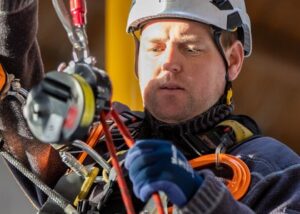Role of a Slinger Signaller - what can I expect from the job?
A slinger signaller is a crucial role in lifting operations, particularly in industries like construction and wind energy. This role involves the safe and efficient directing of crane and lifting operations, ensuring that loads are securely attached, balanced, and moved without causing accidents or damage. The slinger signaller works in close coordination with crane operators, riggers, and other personnel involved in lifting activities.
Responsibilities of a Slinger Signaller
- Load Attachment and Security
- Sling Selection: Choosing the appropriate slings and lifting gear for the load based on its weight, shape, and material.
- Attachment: Securing the load to the crane or lifting equipment using slings, chains, or other rigging materials.
- Load Balancing: Ensuring that the load is properly balanced to prevent swinging or tipping during the lift.
- Signalling and Communication
- Hand Signals: Using standardized hand signals to communicate with the crane operator to guide the movement of the load.
- Radio Communication: Utilizing radios or other communication devices to relay instructions and coordinate operations.
- Safety Coordination: Ensuring that all personnel involved in the lifting operation are aware of their roles and that the work area is clear of unnecessary personnel.
- Safety Checks and Compliance
- Pre-Lift Inspections: Conducting inspections of the lifting gear and load to ensure they are in good condition and compliant with safety standards.
- Risk Assessments: Identifying potential hazards associated with the lifting operation and implementing measures to mitigate these risks.
- Compliance: Adhering to safety regulations, standards, and best practices to prevent accidents and ensure a safe working environment.
- Guiding the Load
- Movement Direction: Directing the crane operator to move the load to the desired location safely and efficiently.
- Positioning: Ensuring the load is placed accurately and safely at its final destination.
- Monitoring: Continuously monitoring the load during lifting and lowering to prevent accidents.
Specialization and Training
The role of a slinger signaller is highly specialized and requires specific training and certification. This training typically includes:
- Rigging and Slinging Techniques
- Types of Slings: Knowledge of different types of slings (wire rope, synthetic, chain) and their appropriate use.
- Load Calculations: Understanding how to calculate load weights and the capacity of lifting equipment.
- Signalling Methods
- Hand Signals: Training in standardized hand signals used to communicate with crane operators.
- Communication Skills: Effective use of radios and other communication devices.
- Safety Practices
- Risk Assessment: Identifying and mitigating potential hazards in lifting operations.
- Equipment Inspection: Conducting pre-use checks on lifting equipment to ensure safety.
- Legal and Regulatory Knowledge
- Standards and Regulations: Familiarity with industry standards and regulations governing lifting operations.
Role on Top of the Wind Technician Job
For a wind technician, taking on the role of a slinger signaller adds significant responsibilities and requires additional skills and knowledge. Here’s how it integrates with their primary duties:
- Complex Lifting Operations
- Turbine Components: Wind technicians often work with large and heavy turbine components. Being a trained slinger signaller ensures these components are lifted and positioned safely.
- Tight Spaces: Wind turbines are often in areas where space is limited, requiring precise lifting and signalling to avoid accidents.
- Enhanced Safety
- Reduced Risk: By being both a wind technician and a slinger signaller, the individual can better manage and reduce the risks associated with lifting operations.
- Holistic Understanding: Combining technical knowledge of wind turbines with lifting expertise leads to a comprehensive understanding of the operations, further enhancing safety.
- Operational Efficiency
- Streamlined Processes: Having dual roles can streamline operations, as the individual can directly oversee and manage the lifting processes, reducing the need for additional personnel.
- Improved Coordination: Better coordination between the lifting team and the technical team, as one person understands the requirements and limitations of both areas.
- Career Advancement
- Skill Diversification: Adding slinger signaller qualifications to a wind technician’s skill set can open up more advanced roles and responsibilities within the wind energy sector.
- Higher Demand: Technicians with dual qualifications are often in higher demand, offering more job security and potential for increased earnings.
Conclusion
The role of a slinger signaller is essential in ensuring the safe and efficient execution of lifting operations, particularly in industries like wind energy. For wind technicians, acquiring slinger signaller qualifications adds significant value, enhancing safety, operational efficiency, and career prospects. This dual expertise allows for a more integrated approach to managing the complex and demanding tasks associated with maintaining and constructing wind turbines.
INTERESTED IN OUR GWO SLINGER SIGNALLER COURSE?
Click the button to more and book.



